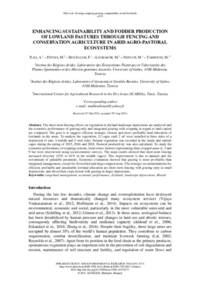Enhancing sustainability and fodder production of lowland pastures through fencing and conservation agriculture in arid agro-pastoral ecosystems

Authors:
The short-term fencing effects on vegetation in dryland landscape depressions are analyzed and the economic performance of grazing-only and integrated grazing with cropping in regard to land capital are compared. The goal is to suggest efficient strategic choices and more profitable land allocation of lowlands in dry areas. To analyze the vegetation, 12 cages each 2 m² were installed at three sides of a depression (4 east, 4 middle and 4 west side). Natural vegetation was recorded in the inside and outside cages during the spring of 2015, 2016 and 2018. Pastoral productivity was also calculated. To study the economic performance of cropping systems, local owner-farmers representing three cropped areas (1, 3 and 9 ha) were interviewed using socioeconomic surveys. The main results showed that short-term fencing increased diversity (24% to 61% in the middle cages). This improvement is due to annuals and the recruitment of palatable perennials. Economic evaluation showed that grazing is more profitable than integrated management, except for diversified and large cropped areas. The strategic recommendations for efficient, profitable and sustainable lowland allocation are short-term fencing with grazing-only in small depressions, and diversified crops mixed with grazing in larger depressions.
